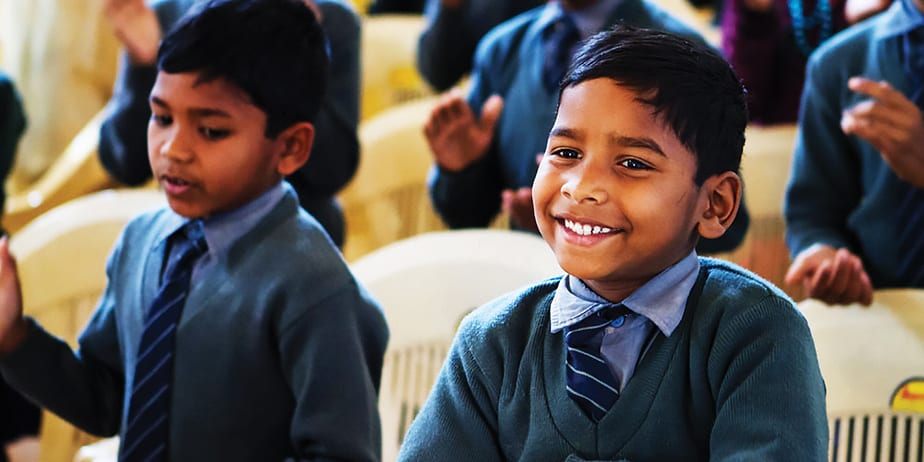The Right to Education Act will only achieve its goals if fee-paying parents participate in the process of making disadvantaged children and their families feel socially included
If one moves out of one’s bubble of the immediate neighbourhood, one can observe a diverse group of people. Take a stroll a couple of blocks down and you can meet the child vendor selling balloons or the handicapped man sitting on his wooden block with alms strewn in front of him. How often do we feel equipped to interact with this diversity beyond tossing the occasional coin in their bucket? Not a lot of times. Tossing the coin most often feels like a job well done.
If you are an economically privileged mortal like me, ever too often you might get uncomfortable in the presence of the have-nots, so much so that you feel a deep sense of “othering”, feeling you have nothing in common with them to reach out for and sustain a conversation. One might even go as far as feeling guilty of possessions while witnessing these have-nots and lock the thought deep down before it becomes too cumbersome to deal with on an everyday basis.
What we all experience in these moments is a lack of social practice to interact with someone different from ourselves. While growing up, we went to our bubbles of private schools, interacted with children from our neighborhood and fostered lifelong friendships with people who wore clothes like us, lived in similar homes and ate similar food. The middle/upper class bubble of children of our generation growing up rarely had the opportunity to interact and foster friendships with disadvantaged children, without letting the class dynamic interfere. We did not have any open, level field to play together because we grew up with class segregation that seeped deep.
Our classrooms did not represent India’s true diversity, we did not have the opportunity to learn from children across the oppressed spectrum, to develop empathy, kindness and social skills to negotiate differences at an early stage. What we learnt instead was that the house help’s son plays outside in the street and we can give him our toy only after it is broken. Hence when we come face to face with him as a grown-up, we know nothing better than exchanging an awkward smile and nod.

However, legislative changes in the shape of the Right of Children to Free and Compulsory Education Act, 2009 (usually referred to as the RTE Act) were meant to flip this entire script for the current generation of schoolgoing children. A particular section of the Right to Education Act now mandates private unaided schools to reserve a quarter of their entry level classrooms for disadvantaged families. What this really means is that for the first time we as a society have given our children a true opportunity to break class barriers and foster friendships while sitting on the same desks, reading the same books and getting taught by the same teachers.
The law, while progressive in spirit, suffers from poor implementation with a national fill rate as low as 32%, with many large states not implementing the policy at all. This means that 15 lakh children are not able to access free private education but also that 45 lakh privileged children are not getting an equal opportunity to study in a diverse classroom. Even for the 7 lakh children that are able to enter the gated walls of these private schools, assimilation into the school culture can be a serious problem as the school administration, teachers and fee-paying parents are themselves a product of a divisive classist society. It is unlikely that they are untouched by biases and prejudices that crop up and are not transferring it into the cognitive awareness of their children.
A six-year-old is not capable of navigating the tension of sitting with the same child in the classroom who was kept outside his home till now when he accompanied his mother, who works as a cleaner. He will most probably choose to avoid this child until told otherwise. Research shows that children in early years learn the most by observing their caregivers and look towards them to validate their hypothesis of the world, so much so that it can conflict with their logical thinking capabilities.
In order to make sure that our children truly reap the benefits of this progressive policy, we would need to shrug off our classist attitudes. Research time and again has proven that socio-economic diversity helps children develop key skills like empathy, communication and conflict resolution for the 21st century. Diversity within classrooms is beneficial for everyone, however the disadvantaged have to walk many extra miles, psychologically and physically to fulfill this promise of diversity.
A disadvantaged family’s experience to accessing these seats can be harrowing, from getting necessary documentation in place that could take months, going through the application process which could mean traveling to each school in states where the system is still offline, to fighting for basics like uniform and books if they are allotted a seat. The psychological experience of crossing boundaries of class and entering elite schools can be burdening for both children and parents, until schools and fee-paying parents walk an extra mile to make sure everyone is comfortable.
A system that demands one group put in extra efforts to provide better results for everyone is unjust to begin with. The way the policy is being implemented now, demands the disadvantaged families walk into our advantaged bubbles to teach us empathy and gain value from diversity.
Depending on schools and situations, these families can be met with responses as varied as warm welcomes and cold shrugs of annoyance. For example, in a workshop with fee-paying parents on the topic, a parent said, “As part of Jain community we are doing a lot for education. We donate to schools for the poor being run by Jain trusts in Rajasthan. But I don’t think poor children should study with our children — their language and behaviour is different and they feel jealous of what rich children have.”
The above statement unpacks many attitudinal issues in us. We deep down believe that segregation is safe, we are not threatened as much by equal opportunity as by integrated opportunity. The argument that it’s not “psychologically safe” for disadvantaged children to study with advantaged children, is constantly evoked by privileged parents as a criticism of the policy. However, the question of who holds the “onus” on creating this “psychological safety” is rarely asked or answered. These arguments can be considered a polite manner of supporting segregation without understanding the benefits of a diverse socio-economic classroom.
Fee paying parents need to take the onus of creating this psychological safety for disadvantaged families within private unaided schools. They need to start this by modelling inclusive behaviour at home towards household staff and other disadvantaged groups that they interact with — moving to having conversations about differences in privilege with their children and ensuring that the learning experience is transferred to school. They can also walk the extra mile to foster friendship with disadvantaged parents in their classroom to advocate for their needs and rights within the ecosystem, using the social capital they enjoy.
A few progressive schools have taken steps similar to these. For example, Delhi’s Modern School has started an initiative to “buddy” mothers from both groups together at the beginning of the academic year to support disadvantaged children in their schooling experience. Similarly, Noida’s Shiv Nadar School factors in a “birthday celebration budget” at the beginning of the school year so that all children have the same experience on their birthday, once inside the school. Some schools tag their higher secondary students for remedial classes in entry grades to foster ownership and ensure academic integration of all children.
Sadly, these examples are just from a handful of schools. Much needs to be done from the advantaged end to fulfill the promise of diversity for our children, to ensure a more empathetic, humane future for our society. If diversity benefits everyone, everyone has to take part in creating it.
(The author is Senior Associate with Indus Action, a non-profit)





